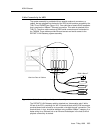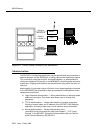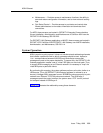
ASAI-Ethernet
Issue 7 May 1998
13-9
■ Maintenance — Provides access to maintenance functions, the ability to
save and restore configuration information, and to view error and security
logs.
■ Port Status/Control — Provides access to port status and control data.
Allows administrators to view status information and terminate client
connections.
For MFB, these screens are located in
DEFINITY Enterprise Communications
Server Installation, Administration, and Maintenance of CallVisor ASAI over the
DEFINITY LAN Gateway
, 555-230-223.
For DEFINITY LAN Gateway application on MAPD, these screens are located in
DEFINITY ECS CallVisor ASAI DEFINITY LAN Gateway over MAPD Installation,
Administration, and Maintenance, 555-230-114.
System Operation
ASAI is a point-to-point protocol. It does not include network addressing elements
that indicate a particular client to which a message should be sent. Instead, a
1-to-1 correspondence between ASAI BRI ports and clients ensures that
messages are sent to the proper destination. To support this, the DEFINITY LAN
Gateway application creates a set of “virtual” BRI ports on the circuit pack. Thus,
to support ASAI messaging on an Ethernet network it is necessary to “map” the
virtual BRI ports to particular clients.
By performing this mapping, the system software performs a function similar to a
LAN brouter. (Thus, the DEFINITY LAN Gateway software is referred to as a
brouter.) It bridges ASAI messages from an ISDN/BRI synchronous point-to-point
network to an Ethernet TCP/IP asynchronous network. The ASAI layer 3
messages remain the same; however, the system uses a TCP “tunnel” protocol
for transport instead of ISDN layer 2.
Figure 13-6 illustrates the relationship among these elements.


















